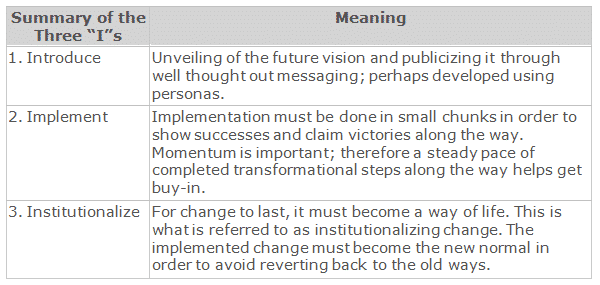Eight Critical Success Factors For Improving Strategy Execution – Part 3 of 4

Are basic management principles are not being applied when it comes to executing strategy? Until organizations make improvements in their strategic planning and execution disciplines, strategy implementation will continue to challenge business leaders. This four-part article series is focused on exploring eight critical success factors related to improving strategy execution. In this segment, Critical Success Factors (CSFs) #5 and #6 are discussed. These CSFs are tied to communication and governance.
CSF #5: Implement strategy governance and keep it simple
Governance and strategy are inexorably linked during planning and in the midst of execution – therefore alignment of these two business components is critical. Governance must first exist, then it must be aligned to planning in order to build in realistic strategic expectations and to measurement cycles in order for real accountability to exist. These are required in strategic planning and strategy execution. Governance should address, at a minimum: master scheduling, metrics and measurements, plan rejuvenation, project planning and plan accountabilities.
An Office of Strategy Management is usually organized at the corporate level to facilitate corporate strategic plan development and oversee implementation. We use the term “oversee” because execution of strategy must be accomplished in an integrated fashion throughout an organization and the OSM is not intended to do all of the work. The OSM’s role is not just strategy development, but also to be the major player in corporate strategic program coordination.
The term Program Management Office (PMO) is related to an OSM in many ways, yet the OSM’s function must be (by definition) significantly broader than managing programs and projects. A PMO is generally a group or department within an enterprise that defines and maintains standards for project management across the organization, seeking to standardize and introduce economies of repetition in the execution of projects. PMOs are generally the source of documentation, guidance and metrics on the practice of project management and execution. In that regard, a PMO’s standards might well serve the OSM – where managing programs and projects is part of the function the OSM provides, but not the primary purpose. Likewise, an OSM should be the source of documentation, guidance and metrics on the practice of strategic and operational planning practices. If PMO standards for project management exist already within the organization, an OSM should be leveraging those assets. If not, it most likely will step up to fill that gap. Perhaps the most important similarity between PMOs and an OSM relates to the form of PMO implementation where governing groups of related projects is part of that function’s scope. In this regard, a PMO’s program governance role is closely related to the OSM’s primary purpose and overlap might exist between the two.
To conclude this point, the OSM performs a strategy governance function for strategic plan development and implementation. Central to governance are the concepts of leadership, authority, accountability, transparency and stewardship. Additional to this is the concept that the OSM serves as a “delivery arm” to ensure the efficient, effective and equitable allocation of funding is directed to strategy-aligned initiatives.
CSF #6: Utilize a Change Management program throughout strategy implementation
There is a subtle reason responsible for the vast majority of organizational struggles with execution. It has to do with failing to properly manage change. That failure may be the result of not engaging employees in the planned transformation, from overly complex plans or changes that are introduced too quickly and ambitiously and therefore begin to unravel during execution.
Managing change begins with sharing the vision of the future-state with those who will be effected and need to know what is afoot. Information and communication are essential in order to help ease resistance to transformation. Introducing change through a well constructed communication plan is the first critical step in the transformation process.
Change that is introduced without setting the proper vision falls flat in terms of being accepted. This happens because employees (and even management) must see a reason and an urgency behind such initiatives; one that motivates them to accept changes to their daily routine. Even with a shared vision and good communication plan, expect change to be feared, resented or passively rejected by the workforce.Without a shared vision, a business will take indirect and meandering paths towards growth and prosperity. The missed opportunity to set and control the business’s own direction will leave it to fate and the actions of competitors to determine the organization’s destiny.
In planning initiatives, it is common for decisions to be made at one level of the organization that deeply affect the whole enterprise or at least specific areas of the organization. When the entire ecosystem of an organization is understand, planners gain a formal understanding of how parts of the organization interact, act, and respond to change. This understanding makes it possible to evaluate the likely consequences, risks, and outcomes of strategic decisions.
Managing change begins with sharing the vision of the future-state with those who will be effected and need to know. Chunk up change into manageable pieces and tout successes frequently along the way. For change to last, it must become institutionalized and become the new norm.
Stand In Your Employee’s Shoes and View Change Through Their Eyes
Help those that will be touched by the transformations throughout the organization truly see the vision and understand it. Plan change through there eyes as well, so that obstacles to acceptance can be understood and anticipated. Allow the organization to see changes happening and accept the small success along the way as evidence that the transformation is working. Continue to train and educate about the change program so that employees adopt the vision of the changing environment and see ownership of their own role in accomplishing lasting transformation.
Recapping
Once a strategic plan has been developed and approved, there should be communication occurring throughout the organization to inform employees of the strategy and what it means to the organization and to them personally (CSF #5). Unfortunately, that usually is not what happens. Strategies can fail simply because they don’t get communicated to all the people involved. Many times, months after the strategic plan implementation is supposed to be underway, employees lower down in the organization have never even heard of the initiative or that it is underway. Governance (including metrics, measuring and managing problems as they impede execution) is at the root of many strategy implementation issues (CSF #6). There is often little follow-through to ensure that the strategic plan is executed.
***
Eight Critical Success Factors – All Segments
Eight Critical Success Factors For Improving Strategy Execution – Part 1 of 4
Eight Critical Success Factors For Improving Strategy Execution – Part 2 of 4
Eight Critical Success Factors For Improving Strategy Execution – Part 3 of 4
Eight Critical Success Factors For Improving Strategy Execution – Part 4 of 4
Category : Strategic Planning


